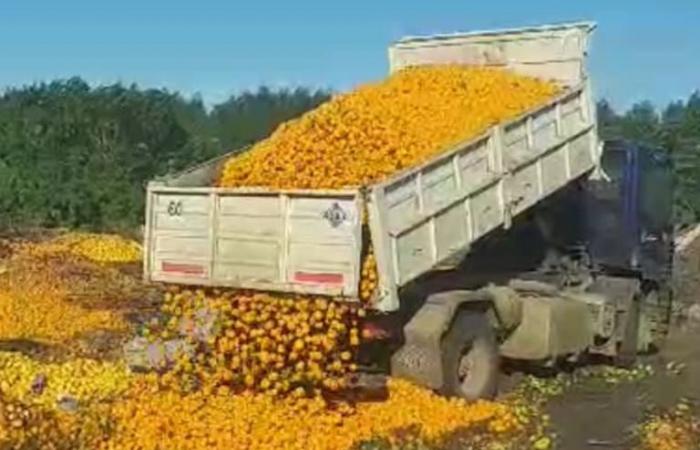
Hear
“It hurts to see how so much fruit is being wasted today”he lamented Marcos Dal Mazo, of the Citrus Growers Association of Villa del Rosario, in the north of Entre Ríos. The image of a truck that he unloaded at least 8000 kilos of tangerines The dumping ground in this town, where mountains of this fruit have already accumulated, reflects the difficult reality of citrus producers in the region. With prices between $40 and $50 pesos per kilo, they are unable to cover production costs. In addition, the local industry is in a state of collapse and cannot absorb more production, which cannot be exported either due to lack of competitiveness. In this bleak scenario, thousands of fruits end up rotting on the ground.
In dialogue with THE NATION, Dal Mazo warned about the harsh reality that exists in “The Town of Las Mandarinas”. This area reaches the highest percentage of production per kilo in the province of Entre Ríos and one of the highest in the country, with approximately 150 million kilos produced by around 400 producers on around 5,000 hectares. However, this year a significant amount of this production is expected to be wasted. “It is difficult to see the images of how they are starting to throw away the fruit. This is mainly due to the fact that there are no sales in the markets, the prices that producers receive are very low and the production costs are very high,” he said.
According to him, 70% of production is destined for the domestic market, 10% for export and another 20% for industry. However, the decline in sales has forced more production to be diverted to industry. “There is excess production in the domestic market and since it is not being sold, it is transferred to the industry, which is also overwhelmed and does not receive every day or works with quotas,” express. The plants have to grind for several days and that generates closures for a certain period.
There are also problems with exports due to the requirements and high production costs that make competition with other countries difficult. “The final cash placed in the port costs us twice as much as what they would pay us or what other countries offer,” he indicated. “This is leading the producer to need to remove the fruit from the top of the plant, either because of the fly [de los frutos que la afecta], to prune or prevent it from falling to the ground, because once the fruit falls to the ground in a large quantity it deregulates a lot which is the issue of pH. “There is no other choice but to try to collect it before it falls and throw it in a place where it will not affect citrus farming,” he pointed. He added that the problem is that the fruit they produce is not suitable for the industry due to its quality and the additional cost involved in producing it, since they are mainly destined for export or the domestic market, not for the industry.
This occurs in a context where producers cannot cover their costs either. He indicated that the producer receives between $40 to $50 per kilo when they should charge at least seven or eight times that value. “It’s a disgrace; we receive one candy per kilo of fruit. That doesn’t even cover the production costs.“For it to pay off, it would have to be around 500 to 600 pesos per kilo to cover costs, without thinking about profitability yet,” he explained. The costs they have are the harvest, the freight, the packaging that involves the wax to give it shine, the light. In addition, there are production costs such as pruning, irrigation, fertilizers, among others: “The end of the month is coming and we don’t know where to get the money to pay, for example, electricity.”
He explained that citrus farming is done entirely by hand, which means that it requires a lot of labor and this makes costs high. In addition, transportation costs are also high. “All this means that the final product that reaches the market has a value that is half of what is needed to cover costs,” he said.
On the other hand, he added that this year the situation worsened because there was an increase in production due to better yields. After years of drought, the plants were stressed and produced less, but since October it began to rain, stimulating greater flowering and fruit production. “While the markets continue to shrink, there is more and more fruit. So we have much less demand and more supply.”he stressed.

